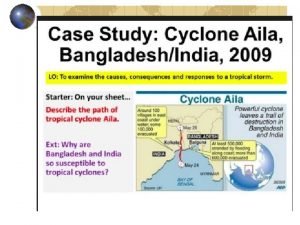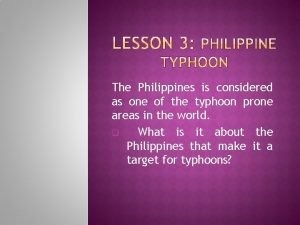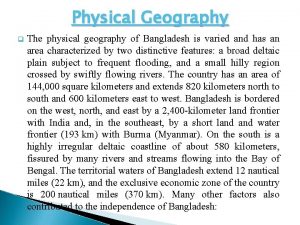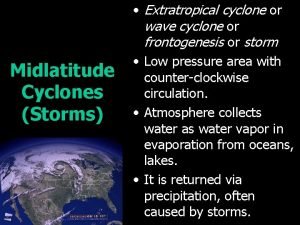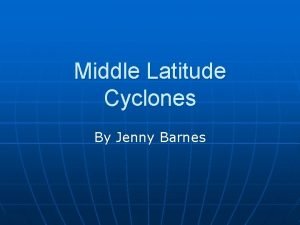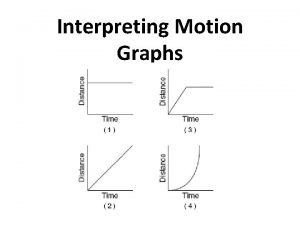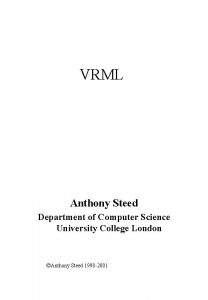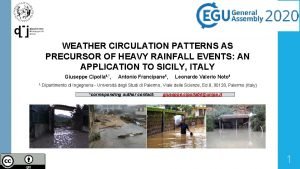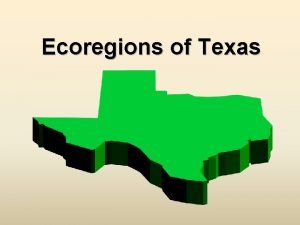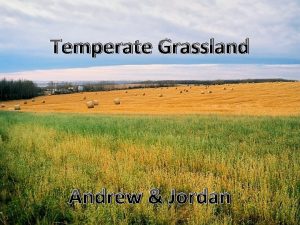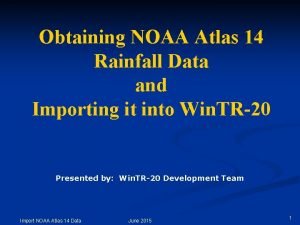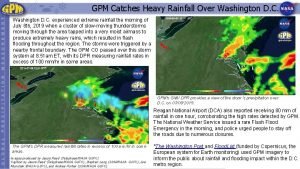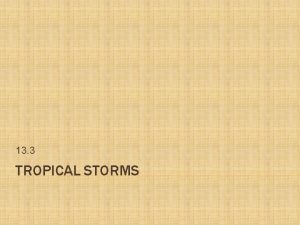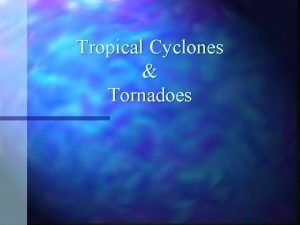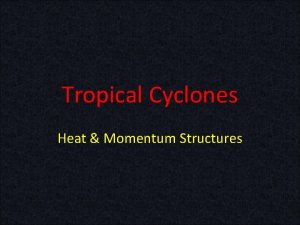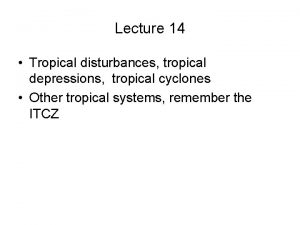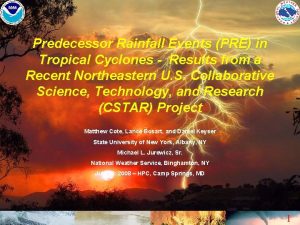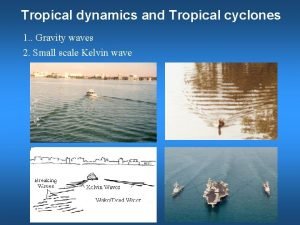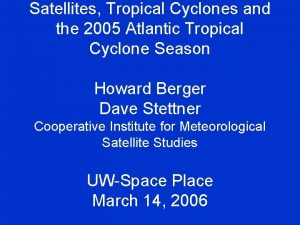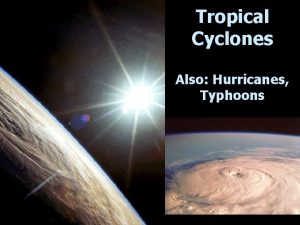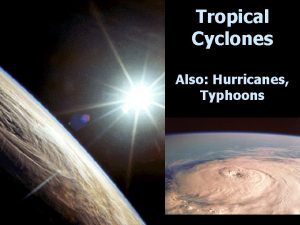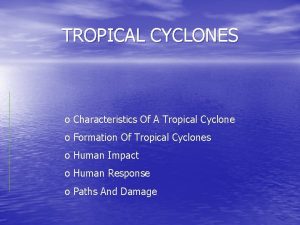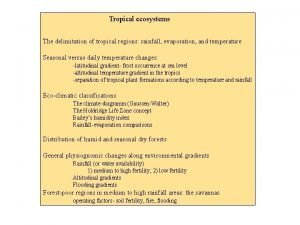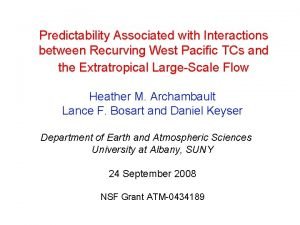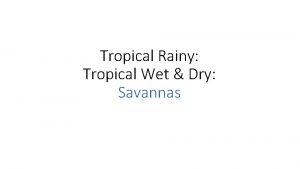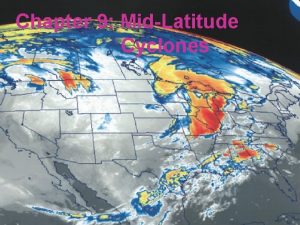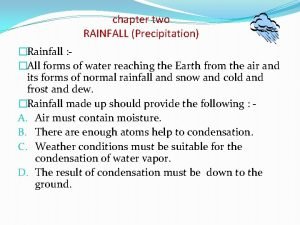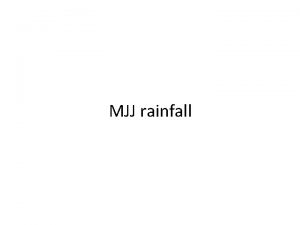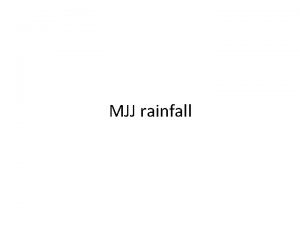Distant Effects of Recurving Tropical Cyclones on Rainfall



























- Slides: 27

Distant Effects of Recurving Tropical Cyclones on Rainfall Production in Midlatitude Convective Systems Russ S. Schumacher 1, Thomas J. Galarneau, Jr. 2, and Lance F. Bosart 2 1 National Center for Atmospheric Research, Boulder, CO and Department of Atmospheric Sciences, Texas A&M University, College Station, TX 2 Department of Atmospheric and Environmental Sciences, University at Albany/SUNY, Albany, NY 13 th Conference on Mesoscale Processes, Salt Lake City, UT 17 August 2009

Purpose • Predecessor rain events (PREs), defined by Cote (2007), occur poleward of recurving tropical cyclones and are high-impact weather events that frequently result in significant inland flooding • Extremely heavy rainfall ( >350 mm in 24 h) and historic flooding occurred in Minnesota and Wisconsin on 19 August 2007, ahead of Tropical Storm Erin • What effect did the transport of moisture by Erin have on the rainfall amounts in the Midwest? Photo from Minneapolis Star Tribune

Predecessor Rain Events (PREs) 0 k m Coherent area of rain displaced poleward of TC Moisture transport from TC toward PRE Event duration ~ 12 h Maximum rainfall rates typically ≥ 100 mm (24 h) 1 Time lag between PRE and TC passage ~ 36 h Bosart and Carr (1978) conceptual model of antecedent rainfall for TC Agnes (1972) ~1 00 • • • Detailed study of PREs in Cote (2007) and in paper to be submitted to MWR by Galarneau et al.

Source: NCAR case-selection archive PRE Erin Forming Organizing 18 Z/18 00 Z/19 WSR-88 D base reflectivity mosaic PRE Erin Mature Weakening 06 Z/19 12 Z/19

250 h. Pa h (dam), 700 h. Pa (10 5 s 1), precipitable water (mm) 850– 500 h. Pa mean wind (kt) 69 0. 5° GFS analysis 850 h. Pa h (dam), (K), wind (kt) 900– 800 h. Pa frontogenesis [K (100 km) 1 (3 h) 1] 925 h. Pa h (dam) 925 h. Pa e (K) 200 h. Pa wind speed (m s 1) 69 0000 UTC 16 Aug 2007

850 h. Pa h (dam), (K), wind (kt) 900– 800 h. Pa frontogenesis [K (100 km) 1 (3 h) 1] 250 h. Pa h (dam), 700 h. Pa (10 5 s 1), precipitable water (mm) 850– 500 h. Pa mean wind (kt) 69 69 925 h. Pa h (dam) 925 h. Pa e (K) 200 h. Pa wind speed (m s 1) 0000 UTC 17 Aug 2007

850 h. Pa h (dam), (K), wind (kt) 900– 800 h. Pa frontogenesis [K (100 km) 1 (3 h) 1] 250 h. Pa h (dam), 700 h. Pa (10 5 s 1), precipitable water (mm) 850– 500 h. Pa mean wind (kt) 69 69 925 h. Pa h (dam) 925 h. Pa e (K) 200 h. Pa wind speed (m s 1) 0000 UTC 18 Aug 2007

850 h. Pa h (dam), (K), wind (kt) 900– 800 h. Pa frontogenesis [K (100 km) 1 (3 h) 1] 250 h. Pa h (dam), 700 h. Pa (10 5 s 1), precipitable water (mm) 850– 500 h. Pa mean wind (kt) 69 H 69 925 h. Pa h (dam) 925 h. Pa e (K) 200 h. Pa wind speed (m s 1) 0000 UTC 19 Aug 2007

250 h. Pa h (dam), 700 h. Pa (10 5 s 1), precipitable water (mm) 850– 500 h. Pa mean wind (kt) 96 850 h. Pa h (dam), (K), wind (kt) 900– 800 h. Pa frontogenesis [K (100 km) 1 (3 h) 1] 96 H 925 h. Pa h (dam) 925 h. Pa e (K) 200 h. Pa wind speed (m s 1) 0600 UTC 19 Aug 2007

250 h. Pa h (dam), 700 h. Pa (10 5 s 1), precipitable water (mm) 850– 500 h. Pa mean wind (kt) 69 850 h. Pa h (dam), (K), wind (kt) 900– 800 h. Pa frontogenesis [K (100 km) 1 (3 h) 1] 69 H 925 h. Pa h (dam) 925 h. Pa e (K) 200 h. Pa wind speed (m s 1) 1200 UTC 19 Aug 2007

WRF simulations • Advanced Research WRF model, version 3. 0. 1. 1 • Initial and boundary conditions: 1º GFS analyses • Two-way nesting, 3 grids: 27, 9 and 3 km grid spacing • KF convection on outer 2 grids, explicit convection on inner grid • New Thompson microphysics: 2 moment prediction of rain • Initialized at 0000 UTC 18 August: 24 -36 hours before the event – At this time, Erin moisture was easy to distinguish from other sources – Wanted to capture the full transport and evolution of the moisture field and resulting convection 3 km 9 km 27 km PBL MYJ Land surface Noah Turbulence 2 D Smagorinsky Shortwave radiation Dudhia Longwave radiation RRTM 6 th order diffusion and positive definite advection

Precipitation Observations (stage IV) 1200 UTC 18 August--1200 UTC 19 August Max = 384 mm Simulation Max = 366 mm mm TS Erin • Overall distribution of precip agrees very well with observations • Maximum accumulation in the simulation displaced slightly north and west of the observed maximum

Extreme-rain-producing MCS • MCS structure in simulation similar to many past studies of elevated MCSs from observations and modeling Trier and Parsons (1993) Maddox et al. (1979) Laing and Fritsch (2000) Schumacher and Johnson (2005)

Sensitivity simulation • How much additional rain fell in the Upper Midwest because of the tropical moisture brought poleward by Erin? • Method: – Modify the water vapor field at the initial time: 0000 UTC 18 August; ~24 hours before the initiation of deep convection in Minnesota – Within the region of increased moisture owing to Erin, anywhere that RH exceeds 55%, reduce it to 55%

Precipitable water 0000 UTC 18 August Control run Note other moisture sources Erin moisture X Erin Reduced moisture run

Precipitable water Control run 1200 UTC 18 August Reduced moisture run

Precipitable water Control run 0000 UTC 19 August Reduced moisture run

Precipitable water Control run 0600 UTC 19 August Reduced moisture run

Precipitable water Control run 1200 UTC 19 August Reduced moisture run

Convective organization and motion Control 2200 UTC 18 August Modified Simulated reflectivity, winds on lowest level, (red contours every 2 K), and frontogenesis (contours, averaged over lowest 5 model levels) • Almost identical at this time, prior to deep convection initiation

Convective organization and motion Control 0300 UTC 19 August Modified Simulated reflectivity, winds on lowest level, (red contours every 2 K), and frontogenesis (contours, averaged over lowest 5 model levels) • • Convection initiates at about the same time, organizes into similar training line of cells; displaced slightly north of the control run Convection is somewhat less intense and less “wet”

Convective organization and motion Control 0600 UTC 19 August Modified Simulated reflectivity, winds on lowest level, (red contours every 2 K), and frontogenesis (contours, averaged over lowest 5 model levels) • New convection still developing upstream in control run, not in modified run

Control Vertical Structure 0000 UTC 19 August Modified (alternating green/white), circulation vectors, and CAPE (black contours every 500 J/kg) • Both have similar frontal structure and plenty of elevated (surface-based) CAPE north (south) of the surface boundary initially

Control Vertical Structure 0400 UTC 19 August Modified (alternating green/white), circulation vectors, and CAPE (black contours every 500 J/kg) • Both have similar frontal structure and plenty of elevated (surface-based) CAPE north (south) of the surface boundary initially • Control run has unlimited “feed” of CAPE from south, which dry run has CAPE locally which is quickly “used up”

Comparison of rainfall amounts • As a point of reference, 188 mm in 24 hours is over a 100 -year rain event for Minnesota • The actual storm is estimated as a 2000+ year event (MN State Climate Office) • Thus, the tropical moisture from Erin took a notable heavy rain event and turned it into an unprecedented event with major impacts

Conclusions • WRF provides a simulation of the 18 -19 August 2007 PRE that is quite accurate – Moisture transport, convective-system-scale processes, and rainfall totals all compare favorably with observations • Structure, organization, and motion of the MCS is similar to past studies of elevated convection on the cool side of a boundary • Trajectory analysis (not shown) and sensitivity simulation underscore the importance of the tropical moisture brought poleward by Erin • The effects of the Erin-related moisture on precipitation were quantified: almost a doubling of the maximum precip amount, and a 31% increase overall

 Describe the global distribution of tropical storms
Describe the global distribution of tropical storms Recurving ridge fingerprint
Recurving ridge fingerprint Who is the modifier of nebular hypothesis in 1796
Who is the modifier of nebular hypothesis in 1796 Ninhydrin fingerprints
Ninhydrin fingerprints Tropical deciduous forest rainfall
Tropical deciduous forest rainfall Bangladesh physical features
Bangladesh physical features Mid latitude cyclone characteristics
Mid latitude cyclone characteristics Air masses and fronts
Air masses and fronts What are middle-latitude cyclones?
What are middle-latitude cyclones? Trusted officer of odysseus
Trusted officer of odysseus Distant
Distant Retrograde motion of mars
Retrograde motion of mars A free bird leaps
A free bird leaps Utilitarian aims of teaching mathematics
Utilitarian aims of teaching mathematics Lod example
Lod example Non western artists
Non western artists Peace is not merely a distant goal
Peace is not merely a distant goal Interpreting motion graphs
Interpreting motion graphs Distant
Distant Distant past tense
Distant past tense Rainfall chapter 2
Rainfall chapter 2 What is an ecoregion
What is an ecoregion Temperate grasslands adaptations
Temperate grasslands adaptations Atlas 14 noaa
Atlas 14 noaa Orographic rainfall
Orographic rainfall Grassy plain with irregular patterns of rainfall
Grassy plain with irregular patterns of rainfall Temperate forest weather
Temperate forest weather Dc rainfall
Dc rainfall
